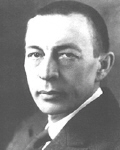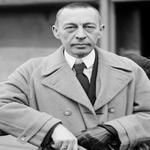

Sergei(Сергей Васильевич) Rachmaninoff(Рахманинов)
Born: 1873Died: 1943
Education: Moscow Conservatory
Career: conductor of the Bolshoi Theatre
Sergey Rachmaninoff, in full Sergey Vasilyevich Rachmaninoff, Rachmaninoff also spelled Rakhmaninov, or Rachmaninov, born March 20, 1873, Oneg, near Semyonovo, Russia, died March 28, 1943, Beverly Hills, California, U.S.), composer who was the last great figure of the tradition of Russian Romanticism and a leading piano virtuoso of his time. He is especially known for his piano concerti and the piece for piano and orchestra titled Rhapsody on a Theme of Paganini (1934). Rachmaninoff was born on an estate belonging to his grandparents, situated near Lake Ilmen in the Novgorod district. His father was a retired army officer and his mother the daughter of a general. The boy was destined to become an army officer until his father lost the entire family fortune through risky financial ventures and then deserted the family. Young Sergey’s cousin Aleksandr Siloti, a well-known concert pianist and conductor, sensed the boy’s abilities and suggested sending him to the noted teacher and pianist Nikolay Zverev in Moscow for his piano studies. It is to Zverev’s strict disciplinarian treatment of the boy that musical history owes one of the great piano virtuosos of the 20th century. For his general education and theoretical subjects in music, Sergey became a pupil at the Moscow Conservatory. At age 19 he graduated from the conservatory, winning a gold medal for his one-act opera Aleko (after Aleksandr Pushkin’s poem Tsygany [“The Gypsies”]). His fame and popularity, both as composer and concert pianist, were launched by two compositions: the Prelude in C-sharp Minor, played for the first time in public on September 26, 1892, and his Piano Concerto No. 2 in C Minor, which had its first performance in Moscow on October 27, 1901. The former piece, although it first brought Rachmaninoff to public attention, was to haunt him throughout his life—the prelude was constantly requested by his concert audiences. The concerto, his first major success, revived his hopes after a trying period of inactivity. In his youth, Rachmaninoff was subject to emotional crises over the success or failure of his works as well as his personal relationships. Self-doubt and uncertainty carried him into deep depressions, one of the most severe of which followed the failure, on its first performance in March 1897, of his Symphony No. 1 in D Minor. The symphony was poorly performed, and the critics condemned it. During this period, while brooding over an unhappy love affair, he was taken to a psychiatrist, Nikolay Dahl, who is often credited with having restored the young composer’s self-confidence, thus enabling him to write the Piano Concerto No. 2 (which is dedicated to Dahl). At the time of the Russian Revolution of 1905, Rachmaninoff was a conductor at the Bolshoi Theatre. Although more of an observer than a person politically involved in the revolution, he went with his family, in November 1906, to live in Dresden. There he wrote three of his major scores: the Symphony No. 2 in E Minor (1907), the symphonic poem The Isle of the Dead (1909), and the Piano Concerto No. 3 in D Minor (1909). The last was composed especially for his first concert tour of the United States, highlighting his much-acclaimed pianistic debut on November 28, 1909, with the New York Symphony under Walter Damrosch. Piano Concerto No. 3 requires great virtuosity from the pianist; its last movement is a bravura section as dazzling as any ever composed. In Philadelphia and Chicago he appeared with equal success in the role of conductor, interpreting his own symphonic compositions. Of these, the Symphony No. 2 is the most significant: it is a work of deep emotion and haunting thematic material. While touring, he was invited to become permanent conductor of the Boston Symphony, but he declined the offer and returned to Russia in February 1910. After the Russian Revolution of 1917, Rachmaninoff went into his second self-imposed exile, dividing his time between residences in Switzerland and the United States. Although for the next 25 years he spent most of his time in an English-speaking country, he never mastered its language or thoroughly acclimatized himself. With his family and a small circle of friends, he lived a rather isolated life. He missed Russia and the Russian people—the sounding board for his music, as he said. And this alienation had a devastating effect on his formerly prolific creative ability. He produced little of real originality but rewrote some of his earlier work. Indeed, he devoted himself almost entirely to concertizing in the United States and Europe, a field in which he had few peers. His only substantial works from this period are the Symphony No. 3 in A Minor (1936), another expression of sombre, Slavic melancholy, and the Rhapsody on a Theme of Paganini for piano and orchestra, a set of variations on a violin caprice by Niccolò Paganini. Rachmaninoff’s last major work, the Symphonic Dances for orchestra, was composed in 1940, about two years before his death.

